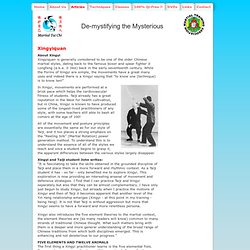

Xing Yi Quan (Hsing I Chuan): Bibliography, Links, Resources, Quotes, Notes, Instructions. March 15, 2008 Cloud Hands Homepage Hsing I Ch'uanXing Yi Quan, Hsing-I 形意拳Bibliography, Links and Resources A.S.K.T. - Xing Yi Quan Ba Gua Zhang (Pa KuaChang): Bibliography, links, resources, quotes, and notes.

Circle walking martial arts. Cartmell, Tim - Shen Wu Discussion Board Topics Central Oregon Internal Arts Association: T'ai Chi Ch'uan, Baguazhang, Xingyiquan and Qigong. Jim dees - Hsing-i [Articles, Pi Chuan] A few years ago in Shanghai, China a foreign martial arts team came to compete and test their skills against different Chinese martial artists.
![Jim dees - Hsing-i [Articles, Pi Chuan]](http://cdn.pearltrees.com/s/pic/th/jim-dees-hsing-articles-chuan-9080917)
The leader of the foreign team wanted to try his skill against the art of Hsing-i chuan. A local Hsing-i Master obliged him. The challenger was told to punch the Hsing-i Master. He tried but was sent back through the air several meters when the Hsing-i master touched him with his arm to apparently block the punch. This event was seen by many and recorded in the Shanghai paper. This is the second in a series of articles that shall examine the fundamental principles of Hsing- I Chuan as taught to me by Mr. The first of the five fists is Pi Chuan. The aforementioned new requirements, or characteristics, are all a part of the bear/eagle concept I explained in my first article of this series.
With this in mind, I would like to share with you a rough translation of an old san xi Hsing-i classic concerning Pi chuan: Martial Tai Chi™ : Techniques. Martial Tai Chi™ : Articles : Xingyiquan. Xingyiquan About Xingyi Xingyiquan is generally considered to be one of the older Chinese martial styles, dating back to the famous boxer and spear fighter Ji Longfeng (a.k.a.

Ji Jike) back in the early seventeenth century. While the Forms of Xingyi are simple, the movements have a great many uses and indeed there is a Xingyi saying that "to know one (technique) is to know ten! " In Xingyi, movements are performed at a brisk pace which helps the cardiovascular fitness of students. Taiji already has a great reputation in the West for health cultivation, but in China, Xingyi is known to have produced some of the longest-lived practitioners of any style, with some teachers still able to bash all comers at the age of 100! All of the movement and posture principles are essentially the same as for our style of Taiji, and it too places a strong emphasis on the "Reeling Silk" (Martial Rotation) power generation method.
Paoquan (cannon fist) Here the association is with cannons and with fire. Martial Tai Chi™ : Techniques. Martial Arts Institute / Means to an End Article. Years ago, in the 90's, Mike Patterson wrote an article for a magazine by the name of "The Internal Martial Arts Journal" and that article was called "Hsing I - A Means To An End.

" Now, in 2012, he has completed the long awaited book by the same title. He has come full circle and so this same title has been selected as appropriate for this work. Mike Patterson is widely considered to be one of the foremost experts in the world on the art of Xingyiquan. With over 40 years experience (at time of writing) as a fighter, coach and teacher, he has authored a masterpiece covering all aspects of this discipline. His immense experience is gleaned from the crucible of continuous and true testing of Xingyi's tenets. This book covers the Hsing I (xingyi) taught to him by Hsu Hong Chi (Xu Hong Ji) in thorough detail.
The book also covers R.S.P.C.T. The book contains 266 pages, at 8 1/2 x 11, and over 700 high resolution photos and illustrations. Utah Valley Hsing-I Chuan/XingYiQuan Training. Xingyiquan to the Max. Hsu Hung-Chi. Hsu Hung-chi Hsu Hung-Chi or Xu Hongji (simplified Chinese: 许鸿基; traditional Chinese: 許鴻基; pinyin: Xǔ Hóngjī) (1934-1984) was a Taiwanese martial artist who specialized in the internal Chinese arts of xingyiquan, baguazhang and taijiquan.

Hsu was born in Taibei, Taiwan in 1934 to a family of six brothers. In school, he was very athletic and participated in swimming, soccer and judo. He began his study of Shaolin kung fu with his father at an early age. He also learned boxing and became a skilled street fighter. After many years of training, Hsu opened his own martial arts school. It incorporates elements of all three of the internal arts (xingyi, bagua, taiji) as well as Shaolin kung fu and qigong. Hsu felt that if a person, no matter what their race or nationality, sincerely wanted to learn and was willing to work hard, then he would teach them. For many years, Hsu went to teach in Japan every year and several of his Japanese students opened schools there.
References[edit]